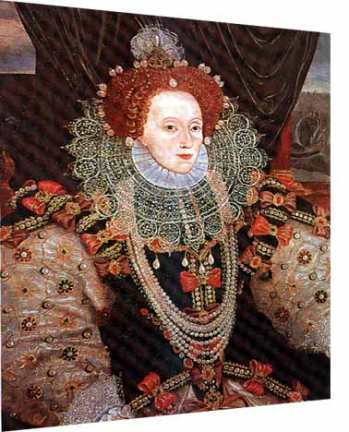 |
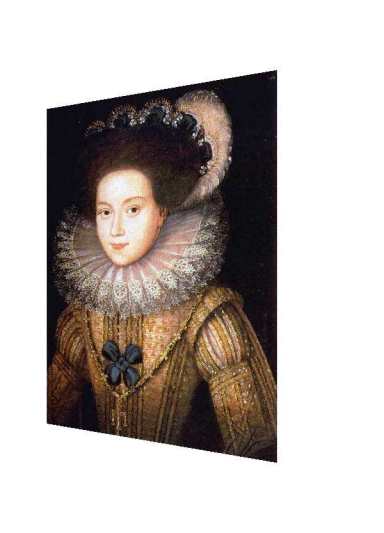 |
| Elisabeth Tudor | Mary Stuart |
 |
 |
| Elisabeth Tudor | Mary Stuart |
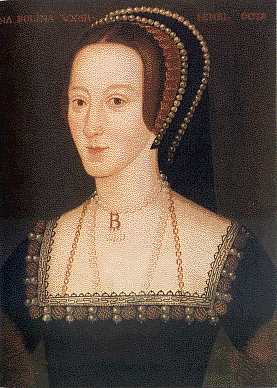
Ann Boleyn
Henry VIII |
Elizabeth took over as Queen of England upon the death of her sister, Mary Tudor, on 17 November 1558. Elizabeth, daughter of Henry VIII and Ann Boleyn, had been despised by her half-sister, Mary, herself daughter of Henry VIII and his first wife, Catherine of Aragon. Elizabeth was considered by many to be the bastard child of Henry VIII as divorce was forbidden by the Catholic Church. In January 1559 Elizabeth passed a short Bill confirming her title in contradiction with the 1554 Act of Succession. "No welcome to the Queen of Scots in my realm" Before 1560 Mary, married to the French king, had posed no threat to Elizabeth. Mary's greedy Guise uncles had made the royal couple sign certain dubious documents and crossed the arms of England with those of Scotland and France. During that time, her mother Mary of Guise who still ruled in Scotland as Regent, had had trouble with the Scottish Protestant insurrectionists. The latter had sought help from protestant England. This culminated in the Treaty of Edinburgh in which it was agreed, among other things, that both French and English troops should withdraw from Scotland, and that Mary and Francis by giving up the use of the English arms should recognise Elizabeth's title. As early as 1560 Mary had wanted to meet Elizabeth to discuss the Treaty of Edinburgh. When, on her husband's death, it became clear that she should return to Scotland, Mary's Secretary Maitland of Lethington, wanted her to travel through England on her way to Scotland to meet Elizabeth. However, Mary had decided to travel by sea straight to Leith. She had asked Elizabeth for safe conduct should she be forced to land on English soil. Elizabeth's response was "there would be no safe conduct and no welcome for the Queen of Scots in her cousin's realm until she had fulfilled her obligations by ratifying the Treaty (of Edinburgh) as she was in honour bound to do". Mary replied that she was only sorry that she had demeaned herself by asking for a passage which she did not need. The English had not been able to prevent her voyage to France 13 years ago. Elizabeth called her vain and inexperienced. Mary said that she was not foolish enough to ratify a treaty which had been drawn up in her husband's reign, without proper advice. As for the quartering of the arms of England with those of Scotland, she said that she had then been under the commandment of her husband and father-in-law, and since her widowhood she had neither borne the arms nor used the title of Queen of England. So why stop Mary from returning to Scotland? Elizabeth was surprised by the political acumen displayed by the young Mary. She was worried about what this would instill in the hot-blooded Scottish warlords. She had hoped that Mary would ratify the Treaty of Edinburgh which virtually embodied a renunciation of the English throne. Elizabeth's intransigent attitude gave her bad press internationally, annoying the French and causing the Venetian Ambassador to comment on the inhumanity of the English Queen in refusing safe passage to "a woman, a widow, unarmed and almost banished from home". On 16 August she had sent Mary a letter protesting her sisterly friendship and denying that she had sent her navy to impeach her journey. Indeed some English ships had been spotted en route. But Mary had already left France by the time the letter arrived. |
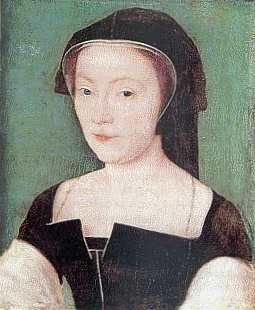
Mary of Guise
|
|
Robert Dudley, Earl of Leicester
Sir Nicholas Throckmorton |
"So the Queen of England is to marry her horse-keeper who has killed his wife to make room for her" When Mary returned to Scotland as a widow, plans for a possible husband began to take shape. Among the suitors were Elizabeth's rejects, the Swedish King and Philip II of Spain who had previously been married to her sister Mary Tudor. But the alliance would have been a political one, a union between a catholic Scottish queen and catholic Spain which scared England. Mary saw Elizabeth as her equal and had no designs on England. She welcomed Elizabeth's envoy assuring him that she wanted to be friends with her cousin. Elizabeth thought that if she could choose a husband for Mary she would in return recognise her right as heir. Her first choice was her favourite Robert Dudley, a man of low birth and accused of having murdered his wife, Amy Robsart. It seemed that she would be Mary's friend only if she chose an Englishman and especially not the King of Spain. Mary did have her heart set on Spain as it would give her power against Elizabeth and John Knox who was also trying to dictate his own choice of a husband, not to mention against the greedy Scottish Lords who were receiving pensions from the English government. When Don Carlos degenerated into insanity, Elizabeth re-opened marriage negotiations with Charles of France, probably to spoil Mary's own chances. In June 1563, Elizabeth had written to Mary urging her to allow the exiled Matthew of Lennox to return home to Scotland to set his affairs in order. In May 1564 Mary agreed but then Elizabeth changed her mind and attempted to revoke his passport. His wife, Margaret, daughter of Margaret Tudor's second marriage, had provoked Elizabeth's anger by trying to promote the marriage of her son, Henry Lord Darnley to Mary in 1561. Elizabeth pretended to be offended by Mary's rejection of Dudley whom she said she would have married herself was it not for the fact that she had decided to end her life in virginity. She made him Earl of Leicester to make him more attractive to Mary. But Mary later claimed that Dudley, who had no intention either of marrying the Queen of Scots, had secretly written to her warning her that the whole thing was a hoax designed to make her look foolish in the eyes of the world, and discourage more suitable suitors. Elizabeth would ensure that Mary did not marry into another foreign power which would have been dangerous for England. Secondly, she knew that Mary would never accept someone of such low birth as Dudley without the sort of collateral she was not willing to provide. But this way, she could keep up the pretence of the negotiations. "How much better were it that we too being Queen and so near of kin, neighbours and living in one isle, should be friends and live together like sisters, than by strange means divide ourselves to the hurt of us both" said Mary "the English reputed the Scots poor but yet you have found us cumbersome enough, we have had loss yet have taken hurt. Why may it not be between my sister and me that we living in peace and assured friendship, may give our minds that some notable things may be wrote by us women as by our predecessors have been before". Suddenly, Elizabeth gave Lord Darnley permission to travel to Scotland. Was she deliberately throwing him across Mary's path? Born in Yorkshire, he was technically an English subject. His mother would remain in London as a guarantee for his good behaviour. At the beginning, Mary and Darnley were no more than just good friends. Finally, Elizabeth announced that she would make no decision as to her title until she was married herself or determined not to marry. This exasperated Mary who lost her trust in Elizabeth. In April, Darnley fell ill with the measles and Mary nursed him day and night. Darnley had been brought to her attention at a moment of mounting frustration and disappointment and it is not surprising that she saw him as an answer to her prayers. She was not to know that under the tall and handsome exterior hid a loutish and unstable youth with all the makings of a vindictive bully. When Maitland travelled to London to seek Elizabeth's approval of the marriage, she pretended to be greatly surprised and offended by the news. She ordered to put Darnley's mother under house arrest and said that she would send Throckmorton to Scotland to put a stop to this nonsense. When he at long last met Mary, she proclaimed herself surprised too as she thought that the choice of an English husband was what Elizabeth wanted. England viewed this union with foreboding. A match of two Tudor children was a threat to the crown, not to mention the fact that they were both catholic. Elizabeth ordered Darnley and his father to come home but they declined. She then sent Lady Lennox, Darnley's mother to the Tower. Mary fell out with both her half-brother James Stuart and Maitland over the Darnley affair and they were given asylum by Elizabeth after the failure of the Chaseabout Raid. Had Elizabeth foreseen all this but misjudged Mary's fearlessness? Anxious to keep face as usual, she solemnly rebuked James for the sin of rebellion against his Sovereign Lady.
|
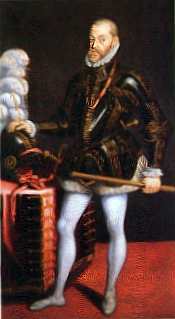
Phillip II of Spain
Henry Stuart, Lord Darnley & his brother Charles
James Stuart, Earl of Moray |
|
"The Queen of Scots is lighter of a fair son and I am but barren stock" After the Rizzio murder Mary eventually reconciled with Moray and Anglo-Scottish relations improved again. Mary wrote to Elizabeth asking her to be godmother to her child. Elizabeth's reaction to the news of the birth of Mary's child was: "The Queen of Scots is lighter of a fair son but I am but barren stock". The matter of the succession became clearer with the birth of Mary's son but Elizabeth still did not marry and still refused to name an heir. To her Parliament who tried to use financial pressure she retorted" "Though I be a woman, I have as good a courage answerable to my place as ever my father had. I am your anointed Queen, I will never be by violence constrained to do anything." Her obstinacy led to revolt after revolt and raised constitutional issues. Finally, giving way to pressure, she reached the compromise that the House of Commons would drop the question in exchange for their freedom of speech.
|
||
|
Meanwhile, Mary was desperate to rid herself of her useless and vindictive husband Darnley: "As for the King our husband,
Amy Robsart 1560 suffering from breast cancer - requested to be left alone, fell down the stairs, broke her neck, Robsart cleared at inquest - cancer? suicide or murder < Bothwell - Darnley murder. Relationship continued. Mary said:
Some evidence that James Stuart (Mary's half-brother) was in close touch with the English government and that he would not have been sorry if Mary had not made it back to Scotland. However, there is nothing to suggest that anything was plotted at the time.
Looks: Mary - tall silhouette, flawless complexion, wide pure brow, heavily-lidded soft brown eyes and rich dark gold hair. Also, genuine outgoing warmth, endearing little acts of kindness, pretty tricks of speech which helped to create that enchanting personality by which men are bewitched. Sent emissary to England to get Elizabeth to recognize her right as heir to the throne of England, which except for Henry's will and her religion would have been her right. But next heir in line was Lady Catherine grey, (sister of Lady Jane Grey) her great-niece. But Elizabeth sent her to the Tower. Elizabeth responded by being suitably vague saying that "she was of blood of England and her nearest kinswoman so that she was bound by nature to love her and even in the time of most offence, when Mary by bearing her arms and claiming the title of my crown should give me just cause to be most angry with her, yet could I never find it in my heart to hate her, imputing rather the thought to others than to herself; as for the title of my crown, for my time I think she will not obtain it nor make impediment to my issue if any shall come out of my body for long as I live there shall be no other Queen of England but I." She said to Maitland who suggested that settling the question of the succession would cement the friendship she retorted: "Think you that I might love my own dwinding sheet? I know the inconsistency of the people of England, how they ever mislike the present government and have their eyes fixed on the person that is next to succeed and naturally men be so disposed". Allusion to how eager her people had been to replace her sister Mary Tudor with herself. Mary replied: "We will do all that in reason may be required or rather enter into a new one such as may stand without prejudice in favour of you and the lawful issue of your body provided that our interest to that crown failing yourself and the said issue may be put in good surety". May 1562 - Mary sent Maitland down for an invitation. June friendly letter from Elizabeth, meeting scheduled for September in Nottingham but had to be cancelled because of events in France. Catherine of Medici and Huguenots against House of Guise = Protestant French looking to Elizabeth for help while Catholics turned to Spain. Mary burst into a flood of tears on hearing the news. Debatable whether Elizabeth would not have found another excuse anyway not to meet her cousin. Mary stayed neutral in the French conflict. In fact, it was that summer that she travelled north and dealt with the rebellious and Catholic Lord Huntly. Elizabeth apologised to Mary for helping the Huguenots saying that she was only showing herself as being a good neighbour. She fell seriously ill with an attack of small pox. The English Council was thrown into panic not being able to decide on who should succeed Elisabeth should she die. The pressure to name an heir now came from a different corner. But Elizabeth did not suffer anybody else to meddle with her right to make that decision. By 1563 she still had not made up her mind but many were against Mary. It was never forgotten that some 20 years earlier, the Scots had rejected a possible union between Mary and Edward, the son of Henry VIII on the grounds that an English king was unacceptable to the Scots.
Female rivalry Elizabeth asked Melville who was tallest, fairest to which he replied that Elizabeth was the fairest in England and Mary in Scotland. But that was no enough for the jealous Elizabeth who then asked Melville who was of the highest stature. Melville had to admit that it was Mary. She retorted that she must then be too high for she was neither too high nor too low. She then wanted to know how Mary passed her time. Melville explained that she liked to read good books when she had the time and sometimes played on the lute. Also wanted to know who danced better.
|